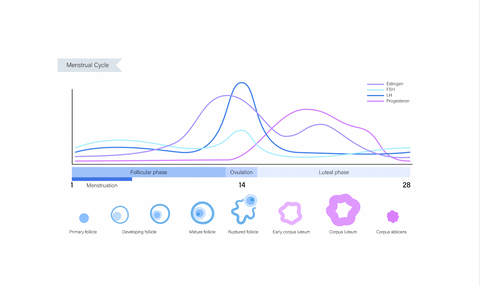What is menstrual syncing?
Chances are you’re already familiar with the body’s circadian rhythm (even if you don’t know it yet)—the naturally-occurring 24 hour cycle that dictates our physical, mental and behavioral patterns. For example: we wake with the sun and rest when it’s dark, typically beginning our day at the time our body is intended to, to experience peak energy and focus.
Now, recall what happens when there’s a disruption to that natural rhythm—like jet lag, or pulling an all-nighter. Everything feels off, and our performance and overall well-being typically follows suit. We’re simply not our best selves when we resist our bodies' cycles. And as a person with a period, if it’s your first time hearing about the infradian rhythm, you may be doing exactly that… without even knowing it.
The same way our bodies naturally follow a 24-hour cycle, people with periods additionally experience a 28-day (give or take) infradian cycle. The menstrual cycle is so much more than just the week you get your period: it’s actually made up of four phases throughout the month, with associated hormone fluctuations and bodily needs that typically accompany each. When you begin to see how you can intuitively tailor your lifestyle to each phase, your body can massively benefit and everything from moods and energy levels, to weight fluctuations and the actual PMS and menstruation itself.
The Four Phases
Menstrual Phase
AKA “the period,” when the uterine lining is shed. Progesterone and estrogen levels dip to their lowest of the month, which some people actually experience as a relief from typical PMS mood symptoms. Iron is lost in the blood, which can cause fatigue, brain fog and decreased endurance. This phase can be accompanied with a range of other symptoms, like discomfort and cramping.
Follicular Phase
Enter a more mellow phase for your body. Think of this as a time of recovery from menstruation, as your body prepares for ovulation. Many say they sleep best during this time of the month, and report feeling energetic.
Ovulatory Phase
Mid-cycle, estrogen levels are at their highest. That means you’re likely to feel your most confident, with increased libido and energy overall. Some may also experience mood changes and breast tenderness while hormones fluctuate. You’re most fertile and likely to conceive during this time.
Luteal Phase
Progesterone levels peak about a week before either preparing for a pregnancy or a period. This can bring on the sleep and mood changes of PMS. Prostaglandin levels increase, which causes inflammation and bloating.



